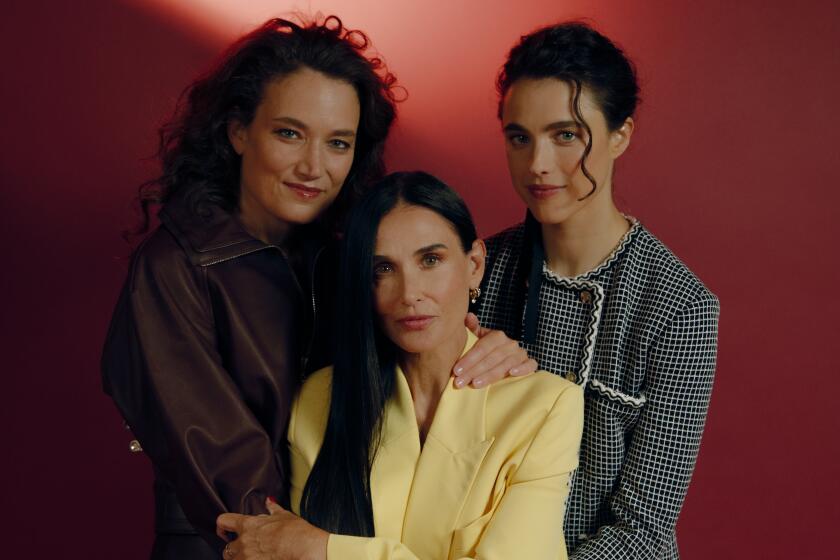
- Share via
Demi Moore was a trouper. Her full concentration was always on the process, according to prosthetic makeup designer Pierre Olivier Persin, speaking from Paris about his work on “The Substance,” Moore’s much-lauded body-horror movie. The actor sat through a makeup process that could take six to eight hours, he recalls.
“She was with us all the way through, which is really rare. She was never looking at her mobile, for instance. Some people are looking down when you try to apply difficult, complicated makeup, and you keep going, ‘Oh, sorry, can you look up for me, please?’ And it’s really boring when you do that for three hours,” he says. “But Demi was just looking very close in the mirror always, all the way through, and that was really great. That’s the best you can have.”
With “The Substance,” the star has a hit movie that speaks to the “violence we can have against ourselves in the pursuit of some idea of perfection.”
Persin, who’s worked on “Game of Thrones” and, more recently, “The Count of Monte Cristo,” first heard of the job through the film’s French executive producer, Nicolas Royer, in 2021. After reading the script, he knew it was something he wanted to do but wasn’t sure he would get the job because “they were looking at others.” A call to read and painstakingly go over the script with the movie’s writer-director, Coralie Fargeat, changed all that.
“It took us three eight-hour days,” he recalls. “We went through the whole script, scene by scene. That’s when I really got the full size of the project.” After that reading, “It’s like, ‘Oh, God, yeah, she wants tons of stuff to be done.’”
That stuff included using a silicone base in the multiple face masks he made and sculpted with paint for Moore and co-star Margaret Qualley.
To get what he needed to make each piece look realistic, Persin used a life cast or scan of the actors — Qualley’s cast was dubbed Monstro. “Then we had lots of mold makings involving lots of nasty products,” he explains. “You need to be very careful with that. Then from all those molds and technical processes, we were able to obtain silicone appliances or foam latex appliances, or whatever appliances or prosthetics that we used only one day because they are very fragile.”
That meant 40 sets of appliances might need to be made for 40 days of shooting, with each applied with a special glue on actors’ faces. “We’re gonna blend the edges, and that’s where the art is, some of it.”
Each was designed to blend with the actor’s movements. “It’s important to watch and film the performer doing weird faces,” he says. “You see how the forehead wrinkles or the neck moves when they smile; if there’s a wrinkle appearing on the cheeks, you try to incorporate that into your sculptures. The makeup will move the same way as your performer. We blend everything and then we paint.”
Once that is done,”We apply fangs or teeth, contact lenses, wigs, a full-body suit.”
A darkly surreal fantasia about Hollywood misogyny, “The Substance” delivers some of the year’s most fearless acting, along with a bold new directorial voice.
Getting the skin tone to match that of the actor requires an even more meticulous approach. When performers come to his workshop for their first live cast or scan, Persin creates skin samples, mixing silicone “until it’s really super close to their own skin. Then, when we mix the silicone to make the appliances, we really match those samples,” he says. “And then on top of that, we add all the little freckles and redness and veins and whatnot, just to give the final touch.”
The designer stresses that although a prosthetic makeup designer does all that they can to make an actor feel as comfortable as possible — such as finding a really good chair and “playing nice music or finding out if they want to chat or be left alone” — poking at the “canvas,” i.e., the actor’s face and body, is not ideal. Nor is sitting inside a full-body prosthetic suit for 10 days, with 2 1⁄2 hours of makeup application.
“Even the best suit in the world, when you are inside as a performer, it’s really hard, buried alive in a really steamy, hot, sweaty, disgusting thing,” says Persin, recalling that Qualley had only one eye visible while in a body suit.
Persin is looking ahead to what will and can happen in his field as technology advances — even with artificial intelligence. “I love digital effects and most of the time we work together,” he says. “We shoot proper elements and then recombine them with VFX, but AI is a different beast, so at first I was like, ‘That’s the end of everything,’” he says. “I tried, quite recently, playing with it because you need to keep your enemy very close, and it’s frightening because it’s quite amazing.
“But if suddenly AI replaces all of us,” he continues, “I don’t know if the audience will enjoy man-made or human-made movies or music, arts or books, or if it does not matter. “
More to Read
From the Oscars to the Emmys.
Get the Envelope newsletter for exclusive awards season coverage, behind-the-scenes stories from the Envelope podcast and columnist Glenn Whipp’s must-read analysis.
You may occasionally receive promotional content from the Los Angeles Times.









